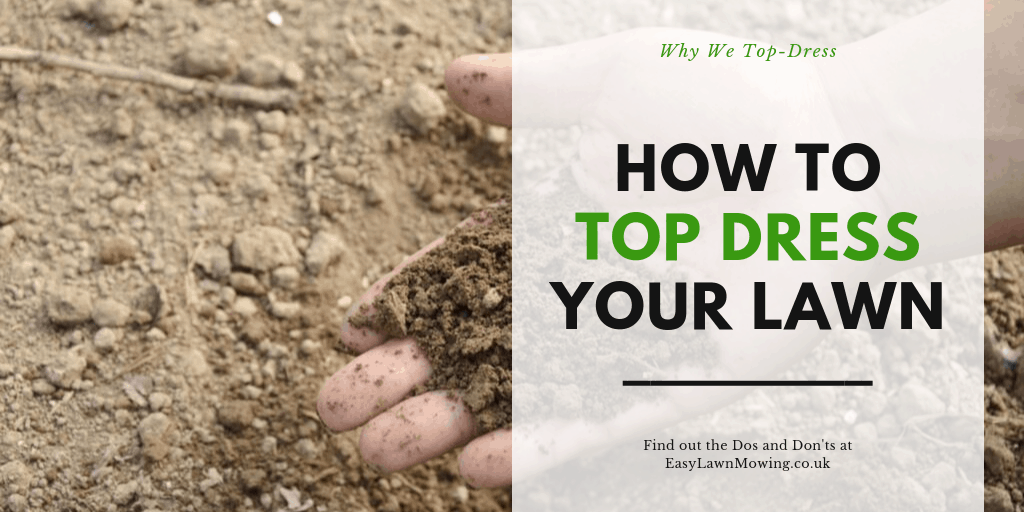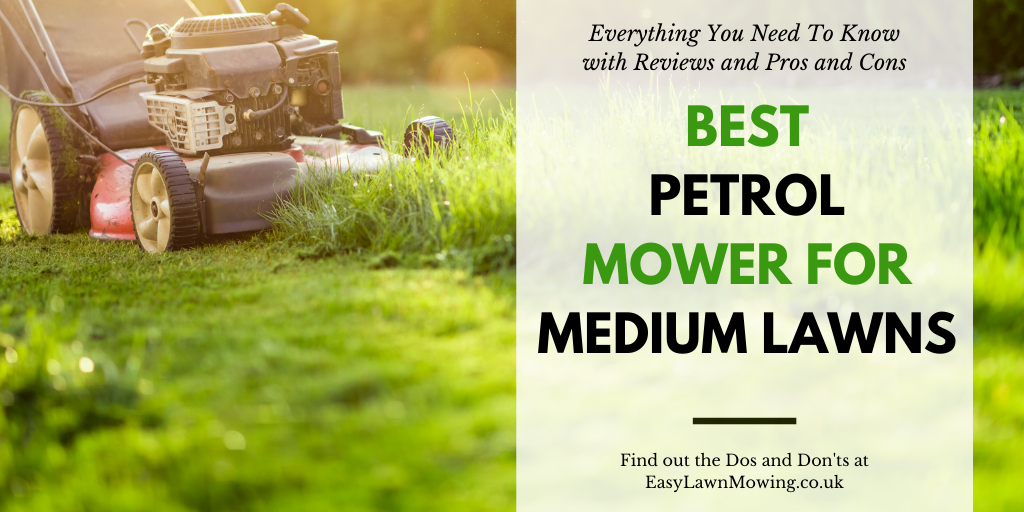Top-dressing is the process of adding a fine layer of specific materials, such as loam, sand, soil and organic matter, to the lawn surface. This has a number of benefits but is mainly used to get the soil into its best growing conditions, to treat irregularities and improve the texture of difficult soils.
Like everything else with lawn care this has to be done correctly to be effective and there is a specific procedure you should follow.
Why We Top-Dress

- It helps to deal with thatch. Because the top-dressing covers the thatch it helps the grass become denser and re-root, it also dilutes the thatch layer, which helps with the natural breakdown of the thatch.
- It improves and maintains the lawn quality, with the addition of essential nutrients it helps to build lawn root structure and healthy growth.
- It improves drainage. If your lawn is susceptible to water-logging then adding a sand based top-dressing with help with the drainage and reduce excess water on the lawn surface.
- It helps build resistance to drought, if you apply a peat based top-dressing.
- It helps with over-seeding, you can mix the seed with your top-dressing to encourage new growth, it will prevent the seed being washed away during the first downpour.
- It will help maintain and level the lawn surface. If you have any little hollows or undulations across the lawn then the top-dressing can fill these in and level your lawn.
- It can improve the fertility of the lawn. With the addition of certain materials and nutrients, the top-dressing can promote the production of healthier and greener grass sprouts.
Just be careful when picking the type of top-dressings you’re going to use. It has to be compatible with the existing soil as it will eventually become part of the root zone. Adding a top-dressing which doesn’t blend with the soil will have next to no benefit, and could make your problems even worse.
When to Top-Dress
Top-dressing can really be done at any point during the growing season but traditionally people will do it either in spring or early summer. Some also top-dress their lawn at the end of the season to maintain the lawn quality. Top-dressing should always be done in conjunction with other lawn maintenance tasks, so if you plan to aerate or scarify your lawn then do so before top-dressing.
Even though they aren’t necessary, they could actually be very useful. Aerating gives access for the top-dressing nutrients to reach the lower ground and level of soil, right down to the bottom of the roots, and the scarifying clears the lawn of thatch so there’s less of a barrier covering the lawn surface.
I know that it can be little daunting to choose the best aerator, scarifier and rake for your garden as there are so many different options to choose from. Naturally you can use manual tool, but as we all know they will be hard work and not suitable for larger lawns. To help you with your search I have selected the be best petrol and electric Lawn Scarifiers and Rakes, please note that some of them are Scarifiers and Aerators 2 in 1 machines too. To see my top selection with a full review, pros and cons, features and functions, click on the link below –
Best Lawn Scarifier and Rakes Reviews
How to Top-Dress Properly

To choose the correct materials for your lawn, you are going to need to know the type of soil you have. Of course the different materials will have different properties and nutrients, so applying ones which your lawn isn’t in need of will just be a waste of time.
You should also build the mix according to the soils composition and health.
Choosing the materials
Types of lawn and their ideal mixtures:
- Sand Based Lawn. This type is likely to be free draining and prone to drought during the summer so go for a mixture that’s 4 parts loam, 3 parts peat and 1 part sand.
- Clay Based Lawn. This type is quite the opposite of the above as it would suffer from drainage problems, i.e. water-logging, so you’re to need mainly sand to improve the drainage. A suitable mixture for this would be 2 parts loam, 1 part peat and 4 parts sand.
- Loam Based Lawn. This soil is in-between the two above, so it won’t suffer from their problems. But that doesn’t mean you can’t apply a top-dressing, go for a mixture that includes 3 parts loam, 1 part peat and 3 parts sand.
As well as aerating and scarifying before you apply the top-dressing to make it most effective, I would mow the lawn on the short side too. This allows the dressing to penetrate the existing soil without causing any damage to the grass.
Also you can fertilise your lawn before your top-dress, but important to remember that if you decide not to top-dress you will need to fertilise your lawn.
How much top-dressing is needed
This is one of the most common questions I receive from homeowners, and it really depends on the length of your mowed grass, how deep you want to top-dress and the size of your lawn.
In general terms, if you lightly mowed and prepared your grass for top-dressing, and you want to top-dress 1 cm deep, then 1 cubic metre is needed for every 100 metre squared of lawn. If your existing grass is longer and you want to top-dress deeper, then you will need to purchase a little more top-dressing.
Procedure

- Measure the size of your lawn and order the right amount of top-dressing for your lawn. (you can cover the full lawn or just fix some of the smaller problem areas)
- Cut your lawn quite short and apply a dry top-dressing to a dry lawn on a dry day. (you will need to keep some depth to the grass, around 3 cm)
- Grab your selected top-dressing suitable for your lawn, and portion it into small piles evenly distributed around your lawn, so that there is a equal sized pile per every metre of grass.
- Now spread the piles into the areas of lawn they have been allocated to. You can use the back of a rake to roughly spread the top-dressing over your lawn, using push and pull motion. Or you can use a spade to scoop the top-dressing and fling it across your lawn. Some homeowners prefer this method as it seems to be a faster and easier way, however there is some practice needed, otherwise you could end up with messy and uneven distribution of your top-dressing.
- Now you need to brush the dressing into the soil, this has to be done a little more vigorously than above so make sure you use a stiff rake or soil leveller. This may be a slow process but this time and care will reward you with a much smoother lawn surface.
- The top dressing should be no more than 75% of the grass blade deep, normally around 1 cm. It is very important for the existing grass blades to be left showing. (if the grass is not showing it means that you have applied too much top-dressing, and the grass will be starved of sun light, and therefore will probably die)
- Water your lawn lightly – you will see that the top-dressing drops down towards your soil.
- Now give the lawn a few days to rest before you mow again otherwise the blades on the mower could get blunt from the contact with the material still left on the grass.
Best Selling Top Dressing
| # | Preview | Product | Price | |
|---|---|---|---|---|
| 1 |

|
Evergreen Lawn Dressing 25L | £12.99 | Check Price on Amazon |
| 2 |

|
Tru-Turf Lawn Top Dressing 25kg | £20.34 | Check Price on Amazon |
| 3 |

|
Laeto Your Signature Garden Lawn & Turf Dressing | Lawn Dressing To... | £16.99 £14.99 | Check Price on Amazon |
Last update on 2024-04-07 / Affiliate links / Images from Amazon Product Advertising API
One other thing, if you do plan on scarifying the lawn or have any bare patches then should include seeds into the operation. You can do this one of two ways: before or after.

If you have loads of top-dressing to work into your lawn, then I suggest you seed afterwards, this way the seed won’t move around.
But if you have only a little layer to work in then you can add the seed first, this also protects it a little from birds and heavy rain.
When top-dressing your lawn, it’s normal to underestimate just how much material you’ll need to cover the lawn and get the correct depth.
In summary, top-dressing is beneficial for your lawn, not only does it provide nutrients, repairs holes, smooths out bumps and uneven lawns, but it will encourage the growth of a lush, thick and healthy lawn for you and your family to enjoy. It will also act as a long term natural fertiliser.
Best mowers to help achieve a perfect lawn
Many homeowners are asking how to maintain a flat lawn with amazing stripes.
Choosing the right lawn mower for you and your lawn is also important as part of your lawn maintenance schedule.
If you want to achieve long lasting stripes on your freshly improved lawn, then I would recommend that you consider a heavier lawn mower with a rear roller that is heavy enough to make an impression, such as a petrol mower.
The alternative is to purchase a separate roller that is filled with sand or water, and will level the lawn as well as produce a striped appearance. Just remember that you will need the extra storage. Below is a list of the best 5 selling rollers available on Amazon –
Last update on 2024-04-14 / Affiliate links / Images from Amazon Product Advertising API
Other lawn care articles
Below I have included a few other related articles to help you with all your lawn care needs.
Red Thread Lawn Disease Treatment
The Best Way to Cut Your Grass
If you found this post interesting then maybe you’d like to see some of my other content and best garden tool reviews, each with full specifications, pros and cons, to help you decide what is the best choice for your circumstances. Visit the homepage on the link below –
Best Lawn Mower and Garden Tool Reviews
As a seasoned expert in the field of garden power tools, I have dedicated over a decade to working with and reviewing a wide variety of lawn mowers. My extensive experience has allowed me to gain a deep understanding of the benefits and limitations of different types of mowers and garden tools.
Over the years, I have honed my skills in writing informative articles and creating helpful videos for various blogs and publications. This has given me the ability to not only recognise what makes a good lawn mower, but also to help you choose the perfect garden tool for your specific needs and requirements.
With my wealth of knowledge and expertise, I am confident that I can provide you with valuable insights and recommendations when it comes to selecting the right lawn mower for your lawn. So, whether you're looking for a battery cordless, electric, petrol, or robotic mower, you can trust in my expertise to guide you towards the best option for your garden.













Hello. I live in FloridA and San Augustine grass is what you erectus most. How cN I identify the type of lawn I have. Could you explain with a little detail how to recognize it PLEASE. I need to aerate my lawn so I will do it with a liquid aerator, it is organic and shipper than a plug aerator. The grass is growing but is not getting attached to the soil. I see a lot of roots and branches, and this never happened before. You input will be appreciated. My E- mail: GEMARINC1@ BELLSOUTH.NET
Hi Mark,
Your article has got me thinking, again, about my so called lawn. My soil or yard base is very rocky, sharp, big and small. They added some soil on top and then sod. My lawn is horrible, help. I really don’t want to have to scalp it and start over. Not sure if top dressing is even the answer.
I learned quite a lot visiting your website on lawn care, I do my own lawn care but never knew there was so much more I had to learn until reading your article today.
I will have to this spring check my soil to see what type of soil I even have, funny how you take care of your lawn for years and never pay attention to the type of soil your lawn has.
Thank you for the great tips
No problem Jeffrey, I’m glad you found my post useful!
If you want any more tips on other aspects of lawn care then have a look at my other posts on my blog. Hopefully they’ll teach some more new things :-)
Its interesting to read this today, as i was just in my backyard and noticed whole and areas where the grass had been removed from the moving of the mood as the snow melts and my lovely dogs play.
How long does this process take to start seeing results? also is it fragile while the grass is re growing? just with pets i would like to have a plan before i start to fix my lawn.
Hi Stephania, you should see results after 1 – 2 weeks and yes it will be quite fragile so I suggest you stay off it for the first couple of days after applying. Then once you start to see the grass grow again you can give a mow and even a watering if needs be.
Thanks for the comment and if you have any more questions make sure to ask :-)